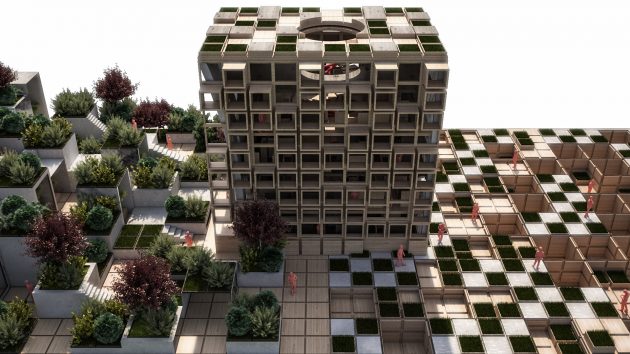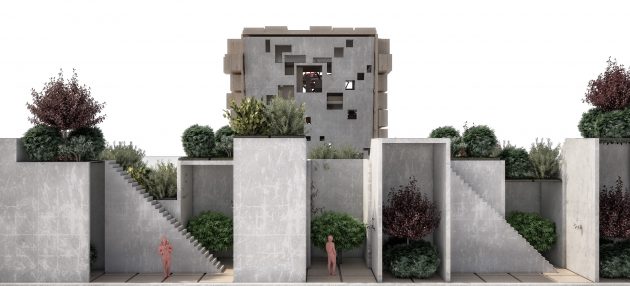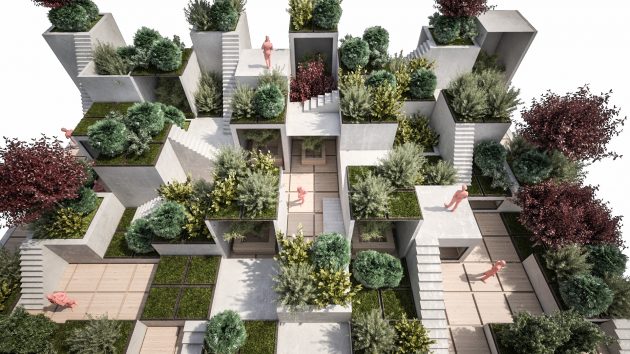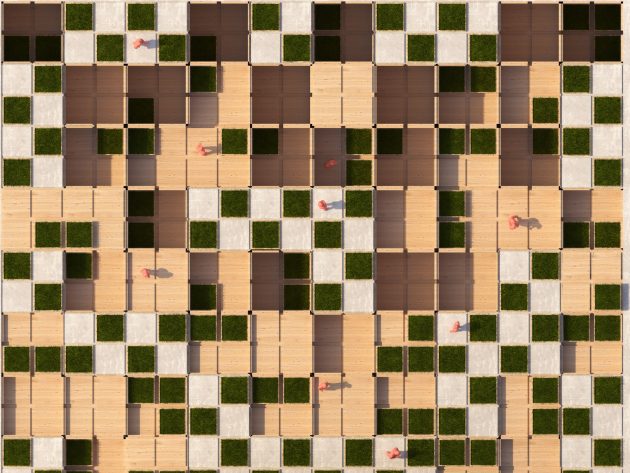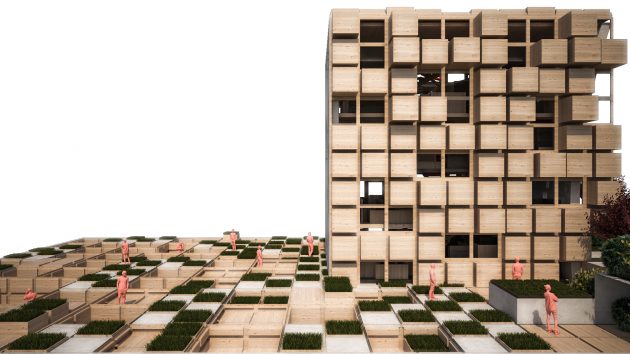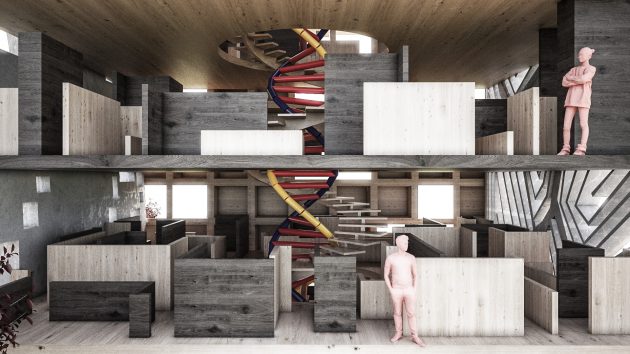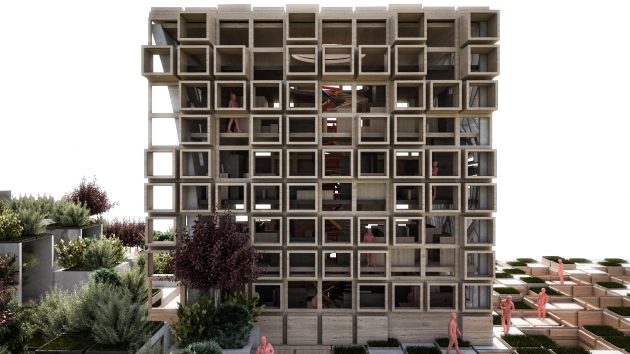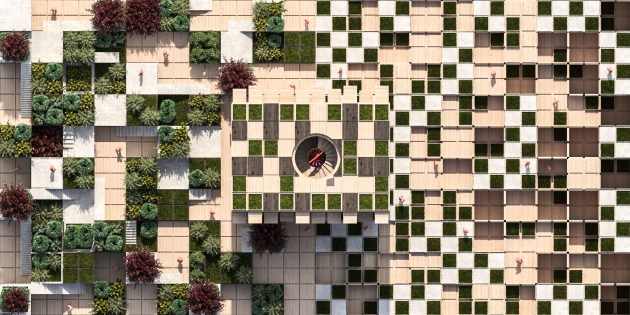Welcome back to another project showcase. Today, we’ve got something out of the ordinary for you.
The Architectural Mythologems have submitted their latest work and it is an exponent of a larger theoretical discourse that they refer to as Architectural Epistemology.
The specific project that was submitted to use is a place where psychology meets architecture, where architecture is also an exegetical tool used to explain deep psychology.
This project replaces “Form follows function” with “Form is the Function of Meaning”.
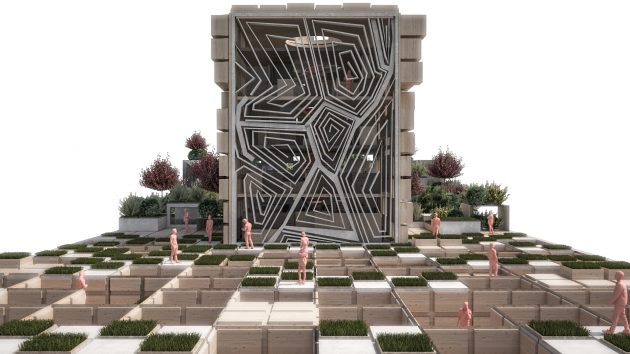
1.1 PERSONA
MONOSEMIC ALLEGORY
(PERSONAL CONSCIOUSNESS ON THE SECOND CORNER)
PERSONA – A term that is now more frequently used in its derivative form, as a personality. The word is derived from Latin, where it originally referred to a theatrical mask. It was part of the cast accessories which was supposed to represent a certain character or emotional traits.
However, this superficial (literally and figuratively) definition of a persona, does not tell us anything other than the fact that it is false, pre-planned and absolutely deterministic in its unfinished existence (the concept of suspending disbelief).
Much more interesting structure and definition of a PERSONA was constructed by Carl Gustav Jung. In his teachings of analytical psychology, the concept of persona is built on motives of ancient definition but has been updated by many socio-psychological elements and suggestions, which makes this newly created definition of a persona much more interesting for processing and transforming. To avoid getting sucked into a linguistic maze of deciphering, and enter the risk of redefining the Jungian concept of persona, in the continuation of this text we will simply print its definition and present it to you for review.
“The persona, for Swiss psychiatrist Carl Jung, was the social face the individual presented to the world—”a kind of mask, designed on the one hand to make a definite impression upon others, and on the other to conceal the true nature of the individual”.
As we found out, the persona is some sort of an “intermediator”, between personality and social environment. In the real world, this intermediary exists in two parallel planes as two parallel entities. There is a “PRIVATE persona” and there’s also a “PUBLIC persona”. However, in the world of social networks, virtual relationships, fabricated idols, and hyper-realism, clear boundaries between those two are abolished under a conditional superiority of the second one. Public persona has become so dominant that the private persona began to disappear. It started breaking down and turning pale under the clear influence and ambitions of the public one.
Here we come to the two-fold problem: 1) The problem of the disappearance of a set of personal characteristics, and 2) complete bondage to a different model that serves as our only representative in the world, and even worse, the only representative to ourselves (a reference to the “ego in the mirror” phenomenon).
This subjective ideality is not false in its nature because it is also the representation of the GOAL. Nevertheless, it should be noted that this goal is fundamentally wrong and it is wrong for the following reasons:
It is consistent and static, not procedural by nature.
The goal is defined by definitive and exclusive destination, on whose end lay person who will finally and absolutely be accepted, not separate and alone.
The embodiment of imaginary self, from the imaginary world, by means of “magical transformations”, and the projection of that completed self onto the current sciolist-halfling identity.
The problem of this public persona is very simple, it is a problem of its artificiality. Persona, as a healthy part of human consciousness and a necessary part of modern civilization, is a byproduct of our interests, thinking, performance, etc., under the influence of social norms (PATHOLOGY OF NORMALITY – Erich Fromm). It is not, or it should not be a pre-planned and designed group of features that we are presuming to be the only correct ones. It is not an anticipated construct of strictly selected valuable constituents. It’s just an extension or epilogue of these constituents that become visible to others. It arises as a consequence, not as a romanticized fantasy in advance, that we have upgraded upon our vaguely defined personality and identity.
In order to explain the existence of public persona most descriptively, we will use diagrams as they will most-illustratively explain previous assertions. We will also do our best to explain how it comes to these “isolated fragmented continent” groups, for which we are certain to stand high in the value system of our environment. We will try to explain how these groups expand, and how they suggest new sets with whom they create the monochrome collage of a public artificial identity.
Every planned design starts with the central ELEMENT. This element occupies the central SPACE on the map of our persona. In the case of public (or in our case only) persona, a central element would be one that is through the elimination or selection, selected as the most valuable one. The element is constructed of clearly defined views/attitudes (not opinions) and exists as a group of them. This group has a clear geometric form in its nature and as such, it is a representative of its solidity, transparency, and focus, but also of its closure (first didascaly).
Given that the idea of a closed set of attitudes is unacceptable according to the social conventions of the today’s neoliberal philosophy, and the idea of the set is to be the exponent of such a philosophy, the set is expanded in those parts where it is the weakest. These critical points are those in which one attitude builds on another, while they stand in opposite directions. (figure 1)
Reasons behind the upgrades in these particular points, in addition to the mentioned above, are the following:
Concealing its own weaknesses, ie the inability to link two opposing ideas, and the group of attitudes must be unambiguous.
The tendency for the expansion of our own views as a new set of arguments that serve and demonstrate that the initial element is accurate.
The development and expansion of our initial element on its satellites are done by the same modus that it has been constructed with. A different process of its constitution would suggest inaccuracy (other possibilities) of its creation, and accuracy of its creation does not only exist in its final phase, but also in the very selection of the best process of APPROPRIATION of truth (The Second Didascaly).
With each following step Persona REDUCTIVELY GROWS. Attitudes create a complicated picture of simplification and repetition, and so they create their own ideogram of mystified simplicity. Their relationship (attitudes) is easily noticeable in their simplistic and rhythmically articulated algorithm. This connection continues to the final borders and designs the picture of this great monosemic allegory (The Second Didascaly).
Despite the fact that our persona is a MONUMENT that is advocating social prosperity (pathology of normality). Despite its position, which exists within the exclusive limits of socially acceptable, and therefore the collective good (normative ethics). Despite its upbringing in a neo-liberal society, it nevertheless has one inherited obligation. With its architecture, it suggests order and norm. These type of suggestions can be found in the father figure that is looming over their children and discipline excessive diversity and deviation. Individualisation is necessary as the idea of growth, but it must belong and be developed under the eye of the social character. The greatest strength of this suggestion isn’t its announcement, but its pose. A pose which is constantly present and which is constantly reminding.
1.2 SHADOW
CARMINA FIGURATA
(PERSONAL UNCONSCIOUS ON THE THIRD CORNER)
Shadow, other or the ugly face of Persona. The Oculus through which one looks at the downside of Persona. Dark dimensions of demonic mono-dialogues which are suppressed by identity under the influence of anonymous authority (public opinion).
Orphic lines in which the shadow prints its deconstructed sentences, are suggested by the persona’s anatomy. The remains of the area in which the persona left its mark, serves as a canvas on which the shadow draws ideograms of stupidity and wisdom. The savage nature of these ideograms is softened by subtle poetics of their sincerity. Ideograms, the place of residence of all Baudelaire’s and Baudelaire’s-related ideals, are presented in (ostensibly) burlesque manner. Their ornaments (read: statements) are nonlinear and hard to read. Understatement is the main attribute of this monstrous image-text. And like every text, this one should also be translated into the language that is rather more understandable. Reading is always a translation, and we’re all trans(to bring)-latus(across)
In order to understand and bring to reason this anti-reason-idea, it is understood that we have to understand the over-rational.
The beginning of this process involves a certain tool. A tool that we would use to suspend our cubical intellectual magnifying glass that is only good at the reading of existing (ipso facto) things, but is completely blind to the understanding of the ostensibly-non-existent over-ideas. These archi-ideas become readable exclusively in the superstructures of imagination.
In these overbuilt spheres of imaginary floors, the world is written in an eidetic (pictorial) alphabet. This kind of alphabet has no obvious beginning or end. There is no prologue, development, and epilogue. No fragmented and isolated groups. However, all the connections, recognition and shaping is actually happening right here. Here, on this phantasmagoric channels of the downside of Persona, are drawn constellations of the true arch (above) – tecture (construction). (Third Didascaly)
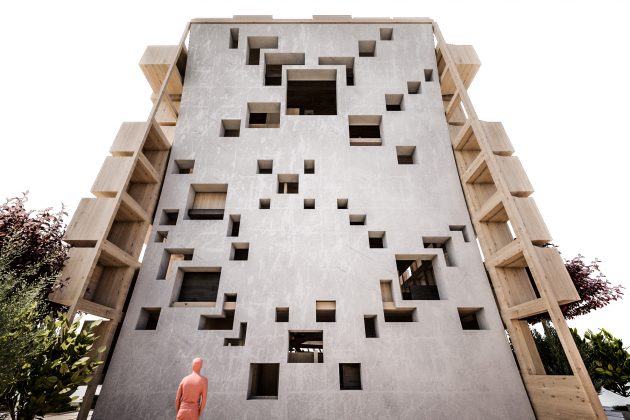
1.3 COLLECTIVE UNCONSCIOUS OR PERSONAL SUPERCONSCIOUS
THE UNDERGROUND CORRIDORS OF THE LABYRINTH
(CIRCLE ON TWO CORNERS)
Collective unconscious – the Syntagma, or (a little bit more philosophical) sintema, which is rarely mentioned, despite the extensive evidence of its existence. In contrast to the personal unconscious and the personal conscious, we are not sure how does the collective unconscious stretch. Does it stretch horizontally, or rise vertically? How many floors or rooms it has and whether that floors-room are time-space by character. The only thing we know is that we experience the existence of this dimension (at least part of it), through symbolic images and archetypes.
Although complicated, the understanding of these events is one of the most important for the process of individuation. However, in the absence of time, interests and personal tools of self-awareness we discarded this huge sphere of absolute humanity and made it neglected. Selective negligence contributed to the reduction of something that is fundamentally human, and therefore, worthy of our attention.
The enforced simplification of man, which resulted in his pseudo-self-understanding, is greeted with broad hands for fear of the unknown and difficult-knowing. Therefore, the superficial architecture of the human psyche has been adopted as the only existing one (1.1 blog-post Persona).
Since the tool for modelling our idea is architecture, we will try to sculpture, in the most illustrative way, a manifestation of the collective unconscious, with the aim of not the understanding, but the recognition of the presence of this vast architrave and a plinth. Its cryptic architecture will not be explained by descriptive methods and didascaly because its enigmatic manifestation in itself will be an analogue of things already known. In order to distance ourselves from any exclusiveness on our side, the motives, which will be selected, are used because of their recognition and symbolism (Figure 1).
There are a lot of assumptions, where, or on what is collective unconscious actually written. As each inscription, this one as well as in a need for a paper and the alphabet. Some of the speculations assume the existence of a gene which is written in the DNA and thus passed from generation to generation. In “psychological discussions,” Jung attributes to the collective unconscious the existence of “Autonomous creative syndrome,” which is described as a self-sustainable and self-sufficient complex from which are works of art born and has nothing to do with the author (artist). With this assumption, art exists as being for itself. There is no discourse that links it to its creator and all of the interpretations can be found only in its(syndrome’s) own introspection. This sort of perspective was particularly dominant in Sartre’s existentialist philosophy, especially in his work “Nausea”.
-Text provided by The Architectural Mythologems

